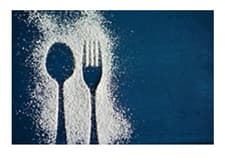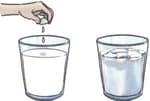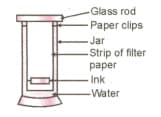Sugar is a pure substance because:

Important Questions on Matter Around Us
| Column A | Column B |
| . Pure substance | a. filter paper |
| . Supersaturated solution | b. water and oil |
| . Filtration | c. carbonated water |
| . Seawater | d. definite properties |
| . Immiscible liquids | e. common salt and water |
Match the statements in the column A with those in column B.
| Column A | Column B |
| 1. The process of removing insoluble particles of suspension by passing it through filter paper. |
(a) Sieving |
| 2. The process of obtaining soluble salt from its solution. | (b) Churning |
| 3. The process of obtaining butter from curd. | (c) Loading |
| 4. The process of making particles of mud heavy with alum. | (d) Filtration |
| 5. The process of separation of chaff from wheat flour. | (e)Evaporation |
Squeeze some drops of lime into a glass of milk. You will see a whitish solid forming after some time. Place a thin cloth over a bowl and pour the liquid on it. The white solid is left behind on the cloth and liquid collects in the bowl.
_____ is the name of the process represented by pouring the liquid through a cloth. (distillation/filtration/chromatography)

A child wanted to separate the mixture of dyes constituting a sample of ink. He marked a line by the ink on the filter paper and placed the filter paper in a glass containing water as shown in figure. The filter paper was removed when the water moved near the top of the filter paper.

(a) What would you expect to see, if the ink contains three different coloured components?
(b) Name the technique used by the child.
(c) Suggest one more application of this technique.
Squeeze some drops of lime into a glass of milk. You will see a whitish solid forming after some time. Place a thin cloth over a bowl and pour the liquid on it. The white solid is left behind on the cloth and liquid collects in the bowl. What is the correct name for the liquid that collects in the bowl?
What would you observe when an aqueous sugar solution is heated to dryness?

